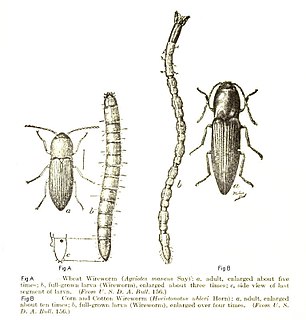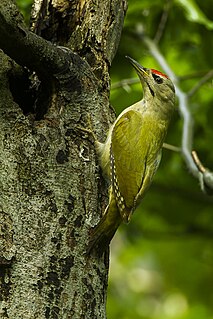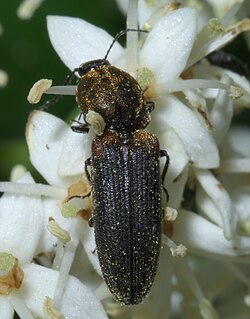
The common gull is a medium-sized gull that breeds in northern Asia, northern Europe, and northwestern North America. The North American subspecies is commonly referred to as the mew gull, although that name is also used by some authorities for the whole species. It migrates further south in winter. There are differing accounts as to how the species acquired its vernacular name.

Insects in the family Elateridae are commonly called click beetles. Other names include elaters, snapping beetles, spring beetles or skipjacks. This family was defined by William Elford Leach (1790–1836) in 1815. They are a cosmopolitan beetle family characterized by the unusual click mechanism they possess. There are a few other families of Elateroidea in which a few members have the same mechanism, but all elaterids can click. A spine on the prosternum can be snapped into a corresponding notch on the mesosternum, producing a violent "click" that can bounce the beetle into the air. Clicking is mainly used to avoid predation, although it is also useful when the beetle is on its back and needs to right itself. There are about 9300 known species worldwide, and 965 valid species in North America.

The grey-headed woodpecker, also known as the grey-faced woodpecker, is a Eurasian member of the woodpecker family, Picidae. Along with the more commonly found European green woodpecker and the Iberian green woodpecker, it is one of three closely related sister species found in Europe. Its distribution stretches across large parts of the central and Eastern Palaearctic, all the way to the Pacific Ocean.

The grey-headed lovebird or Madagascar lovebird is a small species of parrot of the lovebird genus. It is a mainly green parrot. The species is sexually dimorphic and only the adult male has grey on its upper body. They are native on the island of Madagascar and are the only lovebird species which are not native on the African continent. They are the smallest of the lovebird species. It is rarely seen in aviculture and it is difficult to breed in captivity.
The Gansu hamster is a species of rodent in the family Cricetidae, endemic to China. It is the only species in the genus Cansumys.
The Sulawesi soft-furred rat is a species of rodent in the family Muridae. It is the only species in the genus Eropeplus. It is found only in Indonesia. Its natural habitat is subtropical or tropical dry forest. It is threatened by habitat loss.
The gray tree rat is a species of rodent in the family Muridae and the only species in the monotypic genus Lenothrix. It is found in forests in Indonesia and Malaysia. A common species, the IUCN has rated it as being of "least concern".
Merriam's ground squirrel is a species of rodent in the family Sciuridae. It occurs in the states of Idaho, Nevada, and Oregon in the United States.
The Bahamian pygmy boa constrictor, also commonly called simply the Bahamian pygmy boa or the Bahama wood snake, is a species of nonvenomous snake in the family Tropidophiidae. The species is native to the Bahamas. The snake's total length is short, averaging between 30 cm (12 in) and 60 cm (24 in). The Bahamian pygmy boa has the abilities to voluntarily bleed and to coil into a tight ball as defense mechanisms. Four subspecies are recognized, including the nominotypical subspecies, and occur across many different Bahamian Islands.

This is a genus of kelp fly in the family Coelopidae. As of 2017, it is monotypic, consisting of its type species This canus. This and T. canus were respectively circumscribed and described in 1991 by the Australian entomologist David K. McAlpine. It is endemic to southern Australia.
Limonius californicus, the sugarbeet wireworm, is a species of click beetle in the family Elateridae.

Limonius is a genus of click beetles in the family Elateridae. There are at least 30 described species in Limonius.

Limonius auripilis is a species of click beetle in the family Elateridae.
Trigonometopus is a genus of flies in the family Lauxaniidae. There are more than 20 described species in Trigonometopus.
Trichodirabius is a genus of flower weevils in the beetle family Curculionidae. There are at least four described species in Trichodirabius.

Lepyrus is a genus of true weevils in the beetle family Curculionidae. There are more than 70 described species in Lepyrus.
Optioservus canus, the pinnacles optioservus riffle beetle, is a species of riffle beetle in the family Elmidae. It is found in North America.
Trechus hydropicus is a species of ground beetle in the family Carabidae. It is found in North America.
Limonius agonus, the eastern field wireworm, is a species of click beetle in the family Elateridae. It is found in North America.
Limonius subauratus, the Columbia basin wireworm, is a species of click beetle in the family Elateridae. It is found in North America.







